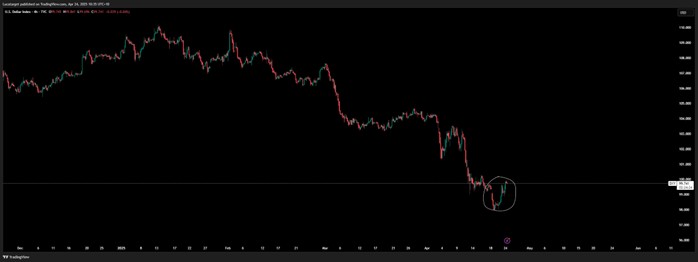
Trump’s Dollar Dilemma Why One Press Conference Can’t Unwind a Historic Slide
 ACY Securities - Luca Santos
ACY Securities - Luca Santos
The U.S. dollar is trying to pick itself up after one of the steepest two‑month declines since the Plaza Accord four decades ago, yet the recovery feels cosmetic. A day of calmer price action on Tuesday sparked by President Trump’s assurance that he has “no intention” of firing Chair Jerome Powell and by Treasury Secretary Scott Bessent’s admission that 125 % reciprocal tariffs on China are “unsustainable” barely dents the bigger picture: from 3 February to 21 April the broad DXY index dropped 10.7 %. Only three modern episodes the 1987 crash, the dot‑com hangover in 2002, and the 2023 inflation shock saw a faster fall.
DXY H4 Chart

Confidence, Once Lost, Demands More Than Words
Washington’s softer rhetoric matters, but words alone cannot rebuild the global appetite for U.S. assets that this administration has shaken. Market psychology shifted the moment the White House unleashed across the board tariffs on 2 April. Suddenly investors had to price not just slower trade but an executive branch willing to weaponize the currency and the central bank. When that line is crossed, every subsequent statement is discounted for credibility.
A genuine floor under the dollar would require at least one of two things:
- Concrete trade deals that carve exceptions to the tariff regime. Quick bilateral agreements with Japan, the U.K. or India would show the U.S. can still negotiate rather than dictate. History suggests those cannot be hammered out in weeks.
- An explicit “strong‑dollar” policy, backed by action think Treasury FX operations or fiscal signals that shrink the deficit path. Talk is cheap; follow‑through is everything.
Until materialises, rallies look like short‑covering.
Europe: Political Theatre Meets Bond‑Market Calm
Across the Atlantic, President Macron is weighing an early parliamentary election once the legal blackout lifts in July. He senses an opening: Marine Le Pen’s embezzlement conviction has dented the Rassemblement National’s polling and replacing her with Jordan Bardella has yet to ignite the base. A fresh mandate might give Macron legislative muscle just as Europe confronts a revived Trump doctrine. Still, French snap elections rarely soothe investors remember last year’s scare. The twist this time is that demand for Eurozone paper is booming. February balance‑of‑payments data show Japanese institutions bought €1.6 trillion in core‑EZ bonds, the fattest monthly ticket since 2019, with French OATs leading the charge.
The message: global capital is happy to trade some French political noise for a haven from tariff‑heavy America.
Asia Watch: Yen Poise and Policy Patience
That same Japanese bid also explains why EUR/JPY has inched higher even as U.S. yields yo‑yo. For now, the Bank of Japan is content to stay in wait‑and‑see mode, letting the yen act as a gentle shock absorber while capital looks for alternatives to Treasuries.
EURJPY H1 Chart

What I’m Watching Next
- G‑7 finance ministers meet in Stresa tomorrow. Expect coordinated push‑back against U.S. tariff escalation; any joint communiqué that stresses “excess volatility” in FX could embolden dollar bears.
- Fed speakers (Governor Waller tonight, Beige Book yesterday). So far the Beige Book flagged “rising uncertainty around tariff policy” rather than inflation angst hardly a narrative that rescues the dollar.
- U.S. housing data. If new‑home sales keep surprising on the downside, recession whispers will grow louder, further undermining the currency.
Trading Takeaway
I continue to treat dollar bounces as opportunities to re‑enter core shorts. In FX I prefer EUR/USD dips near 1.1050 and AUD/USD dips near 0.6250, mindful that Australia is less exposed to direct tariff fallout than Canada or Mexico. Gold remains my macro hedge so long as spot holds above USD 3,300/oz.
Markets can forgive policy mistakes; they struggle to forgive uncertainty. This week’s reversal in tone from Washington is welcome, but without hard evidence a signed deal, a policy rollback, a credible fiscal anchor the path of least resistance for the dollar is still lower.
This content may have been written by a third party. ACY makes no representation or warranty and assumes no liability as to the accuracy or completeness of the information provided, nor any loss arising from any investment based on a recommendation, forecast or other information supplies by any third-party. This content is information only, and does not constitute financial, investment or other advice on which you can rely.
LiquidityFinder
LiquidityFinder was created to take the friction out of the process of sourcing Business to Business (B2B) liquidity; to become the central reference point for liquidity in OTC electronic markets, and the means to access them. Our mission is to provide streamlined modern solutions and share valuable insight and knowledge that benefit our users.
If you would like to contribute to our website or wish to contact us, please click here or you can email us directly at press@liquidityfinder.com.
